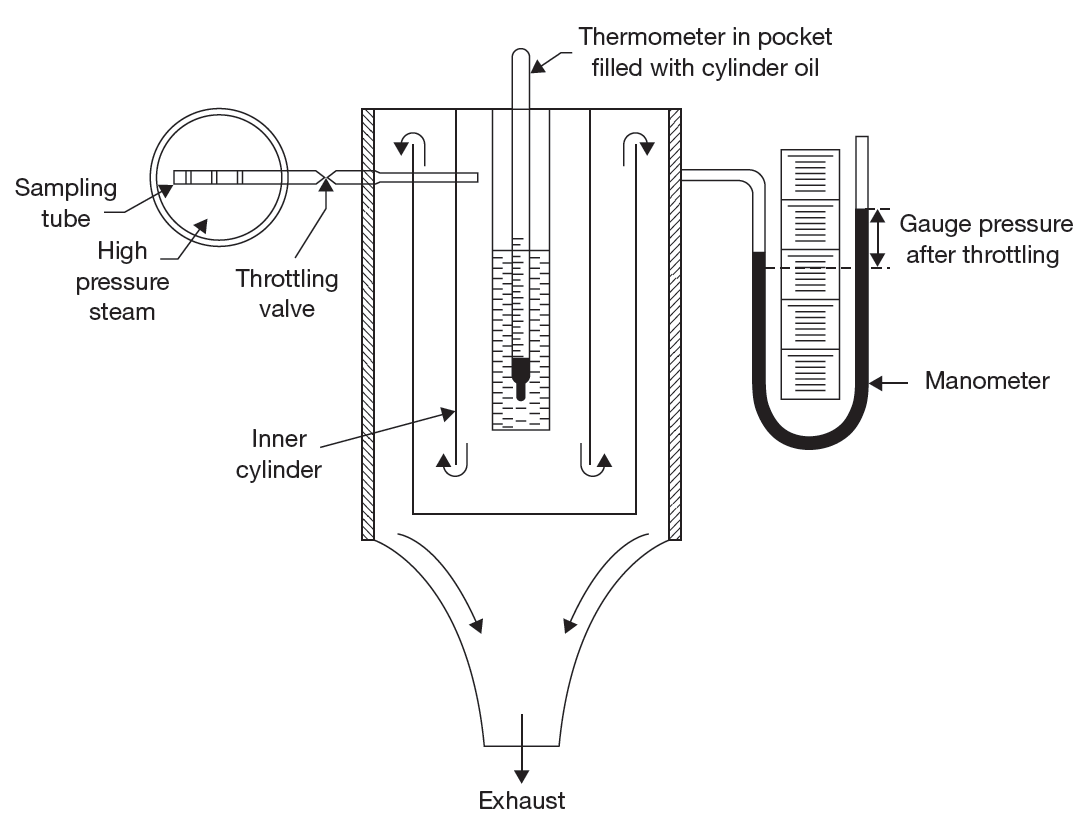Working Principle of Throttling Calorimeter
The working of a throttling calorimeter is based on the throttling process, which is an isenthalpic process (constant enthalpy process). When wet steam at high pressure passes through a throttling valve, it expands suddenly, causing the steam to become superheated or approach a drier state. The dryness fraction of steam is then calculated based on the temperature and pressure measurements after expansion.
The key thermodynamic concepts involved in the working principle are:
- Throttling Process (h₁ = h₂): The enthalpy before and after expansion remains constant.
- Superheated Steam Condition: If the steam becomes superheated after throttling, its properties can be used to determine the initial steam quality.
- Dryness Fraction (x): If the steam remains wet after throttling, additional calculations are required to find the exact quality of steam.
Mathematical Expression for Dryness Fraction
The dryness fraction \( x \) can be determined using the enthalpy equation:
\[
h_1 = h_2
\]
For wet steam:
\[
h_1 = h_f + x h_{fg}
\]
For superheated steam after throttling:
\[
h_2 = h_g + C_p (T_2 – T_g)
\]
By equating these:
\[
h_f + x h_{fg} = h_g + C_p (T_2 – T_g)
\]
Solving for \( x \):
\[
x = \frac{h_g + C_p (T_2 – T_g) – h_f}{h_{fg}}
\]
where:
\( h_f \) = Enthalpy of saturated liquid at initial pressure
\( h_{fg} \) = Latent heat of vaporization
\( h_g \) = Enthalpy of dry saturated steam
\( C_p \) = Specific heat capacity of superheated steam
\( T_2 \) = Superheated temperature after throttling
\( T_g \) = Saturation temperature at final pressure
Parts of a Throttling Calorimeter

A throttling calorimeter consists of the following main components:
- Sampling Tube: Extracts a sample of steam from the steam pipeline. Ensures that the steam entering the calorimeter is representative of the overall system.
- Throttling Valve: A narrow orifice or valve that allows high-pressure steam to expand suddenly. It causes the pressure drop and leads to superheating (if conditions are met).
- Inner Cylinder: The chamber where the throttling expansion occurs. Ensures proper mixing and expansion of steam before measurement.
- Thermometer (Pocket Filled with Cylinder Oil): Measures the temperature of steam after expansion. The pocket filled with cylinder oil helps stabilize temperature readings.
- Manometer: Measures the pressure after throttling. Helps determine steam properties after expansion.
- Exhaust Outlet: Allows the expanded steam to exit after measurement. Ensures continuous flow through the calorimeter.
Advantages of Throttling Calorimeter
- Simple and Accurate: Provides a reliable method to determine steam quality.
- Requires Minimal Equipment: Uses only a throttling device, thermometer, and pressure gauge for measurements.
- No Moving Parts: Increases durability and reduces maintenance costs.
- Provides Direct Superheated Steam Data: Eliminates the need for complex calculations in most cases.
- Suitable for High-Pressure Steam: Can handle high-pressure steam samples effectively.
Applications of Throttling Calorimeter
- Power Plants: Used in steam power plants to measure steam quality and improve turbine efficiency.
- Boilers and Steam Engines: Helps in determining the efficiency of boilers and steam engines.
- Industrial Processes: Used in chemical and food industries where steam is a key part of the process.
- Research and Testing Laboratories: Used in thermodynamics experiments and educational demonstrations.
Disadvantages of Throttling Calorimeter
- Not Suitable for Low-Pressure Steam: If the steam is not dry enough after throttling, the method becomes inaccurate.
- Requires Initial High-Pressure Steam: The method is effective only if the steam becomes superheated after expansion.
- Potential Measurement Errors: Temperature and pressure fluctuations can cause errors in the calculated dryness fraction.
- Limited Range of Steam Quality Measurement: If the steam is too wet before throttling, it may not become superheated, leading to invalid results.
Conclusion
The throttling calorimeter is an essential tool in thermodynamics and steam engineering, providing a simple and effective method to determine the dryness fraction of steam. While it has limitations for wet steam, its advantages make it a widely used device in industrial and research applications.